In the world of modern business, data reigns supreme. It holds the key to making smarter decisions, enhancing performance, and achieving organic growth. Remarkably, research from Harvard Business Review indicates that leveraging data analytics can drive a remarkable 10% to 20% revenue growth for sales and marketing teams. With such potential, B2B teams are now increasingly turning to predictive data insights, especially during the prospecting phase of the sales cycle. By swiftly identifying high-purchase probability buyers, businesses can expedite conversions and pave the way for valuable sales revenue.
However, with the vast array of data types available, it’s crucial to discern which ones will truly streamline your B2B prospecting efforts. Here, we explore five essential data types that can propel your prospecting activities and help you discover high-potential target customers:

Firmographic Data
Firmographic data refers to the intricate organizational details of your target accounts. It encompasses a wealth of company-specific information, including industry type, geographic location, financial health records, growth trends, customer base, and key decision makers. Embracing firmographic data is the first step towards effective prospect segmentation. By breaking down your prospects into smaller, specialized groups, you can achieve enhanced sales personalization and prioritize your prospects, ultimately fostering greater engagement and boosting customer conversions.
To source firmographic data, various methods are at your disposal. You can utilize social platforms like LinkedIn, explore business directories, tap into contact databases or CRMs, or even consider purchasing firmographic data from trustworthy vendors. While data accuracy can sometimes pose a challenge due to employee turnover and changes, smart sales tools with data enrichment capabilities, such as Klarity, can help mitigate inaccuracies and streamline the prospecting process. By integrating your existing CRM with a sales prospecting tool, you create a seamless solution to capture and record enriched contact data from your target accounts, empowering your CRM to be the ultimate source of truth for all prospecting endeavors.
Technographic Data
Technographic data, on the other hand, offers insights into the technological landscape of an organization. It delves into the products, services, and solutions used by the company, providing valuable information about their tech stack, implementation details, and potential challenges.
Understanding the technological preferences of your target customers enables you to craft tailored product offerings that align perfectly with their needs. To source technographic data, you can issue surveys to technology users within your target companies, extract information from their websites using scraping tools, or partner with reliable third-party vendors. Collaborating with a reputable vendor ensures access to comprehensive and reliable technographic data sets from across the web, streamlining your prospecting efforts and setting you on the path to success.
Recency Data
Recency data plays a crucial role in B2B prospecting for two compelling reasons. Firstly, it allows you to gauge the time elapsed since an existing customer’s last purchase. This insight is invaluable for driving product renewals and uncovering cross-selling opportunities within your current customer base. Secondly, recency data aids in optimizing customer prioritization. Customers who have made recent purchases or multiple purchases over a given period are statistically more likely to make additional purchases, making them high-priority prospects for your sales team.
To source recency data, all you need is your customer database. By analyzing your current accounts, you can identify recent transactions and prioritize customers accordingly. Armed with this information, you can devise effective cross-selling strategies and deliver customized offerings to your recent buyers. To take prioritization efforts to the next level, consider adopting the RFM valuation model. This model combines recency, frequency, and monetary purchase values to provide a deeper understanding of your customers’ buying patterns and overall likelihood of making additional purchases. With the RFM model, you can identify specific customer segments that respond best to your sales outreach.
Engagement Data
Engagement data is a goldmine of information encompassing all interactions your prospects or existing customers have with your company across various channels. From social media interactions to digital ad engagements and website activities, engagement data offers valuable insights that can inform and optimize your B2B prospecting efforts.
By analyzing engagement data, you can target prospects more effectively, develop ideal nurture paths for high-priority prospects, identify the most relevant content for your target audiences, determine the most effective channels for interaction, and personalize your outreach based on your prospects’ specific interests. Collecting engagement data can be accomplished through first-party, second-party, or third-party data sources.
First-party data is collected from your company’s own digital properties, such as your website, mobile app, and social media accounts. Second-party data, on the other hand, is the first-party data of another organization that you can leverage to gain additional insights on your target prospects. Lastly, third-party data refers to customer information collected outside your owned-and-operated properties, obtained through partnerships with third-party data vendors. By combining data from these various sources, you gain a holistic understanding of your buyer personas and can build more detailed buyer profiles.
Intent Data
Last but certainly not least, intent data is the Holy Grail of prospecting metrics. It serves as a powerful gauge of a prospect’s interest in making a purchase. By identifying specific actions that signal purchase intent, businesses can pinpoint prospects who are primed for sales interaction.
Various activities can signal true purchase intent, including searches for keywords related to your product, interactions with chatbots, downloads of gated content, registrations for webinars or live events, requests for meetings or product demos, and research on customer or product reviews. These down-funnel behaviors indicate that a prospect has progressed far enough in their buyer’s journey to be receptive to sales outreach. Armed with intent data, prospect prioritization becomes a more straightforward task, enabling you to focus on prospects who are genuinely interested and more likely to convert.
To source intent data, you can tap into ad platforms to track prospect keyword searches, use search engines to identify the keywords buyers use when researching your products, monitor web traffic and click-through data to ensure your website and content align with your prospects’ interests, and even utilize web scraping tools to gather information on prospects expressing purchase intent.
The Power of Data-Driven Prospecting
Incorporating firmographic, technographic, recency, engagement, and intent data into your B2B prospecting strategy is the key to unlocking unprecedented success. By embracing data insights, you can expedite conversions, fill your pipeline with high-potential opportunities, and propel your business forward in the competitive B2B landscape. So, harness the power of data-driven prospecting, and elevate your prospecting game to new heights of success.”

